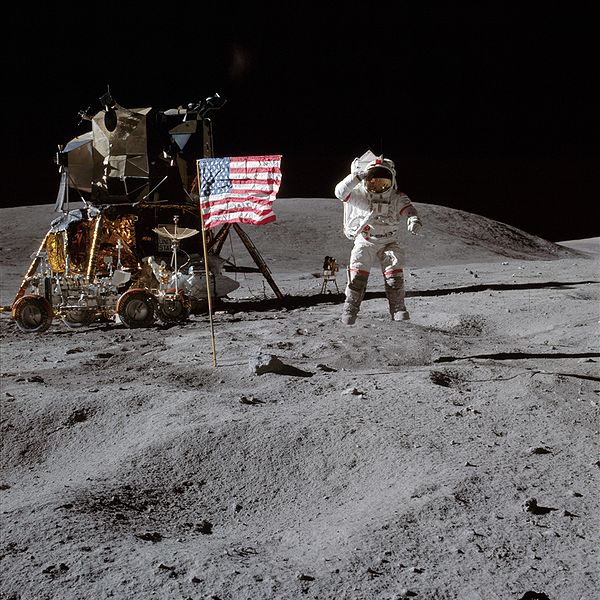
Forty-five years ago, this week, Apollo 16 landed late on the surface of the Moon…and a carefully choreographed flight plan was instantly thrown into disarray. As outlined in yesterday’s AmericaSpace history article, a problem had been detected with the big Service Propulsion System (SPS) engine aboard the Command and Service Module (CSM) and only after several hours of deliberations were the crew given the go-ahead to perform a Powered Descent and guide the Lunar Module (LM) down to the surface. By the late evening of 20 April 1972, Commander John Young and Lunar Module Pilot (LMP) Charlie Duke had touched down on an undulating plain, midway between a pair of craters, nicknamed “North Ray” and “South Ray”.
Against all the odds, humanity’s fifth manned exploration of the Moon was underway.
However, there had been a six-hour delay and that prompted Mission Control to recommend that Young and Duke go to sleep before the first of their three Moonwalks. Originally, it was anticipated that they would go outside shortly after landing and the decision to change tack would have ramifications on the flight plan. On the other hand, having Young and Duke perform a strenuous Extravehicular Activity (EVA) so soon after an arduous landing would force them to remain awake for a 27-hour day. The crew were game, but Flight Director Gerry Griffin opted to let them rest first. The changing of mission plans even led to serious discussions about canceling Apollo 16’s third Moonwalk.
Fourteen hours later, at midday EST on the 21st, Young bounded down the ladder of the LM—which he and Duke had nicknamed “Orion”—and became the ninth human to plant his boots in lunar soil. “There you are, our mysterious and unknown Descartes highland plains,” he said. “Apollo 16 is gonna change your image!”
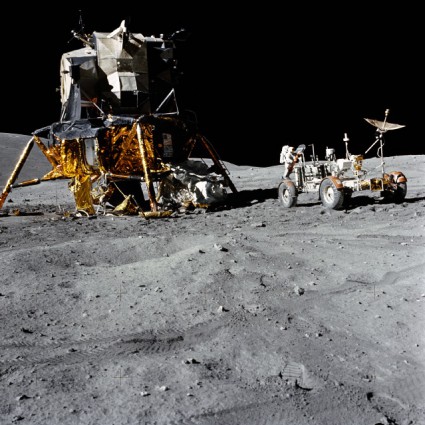
The late landing already meant that the astronauts could not take telephoto pictures of a nearby landmark, Stone Mountain, in the early lunar morning, but Young quickly set to work unfolding the battery-powered Lunar Roving Vehicle (LRV) from Orion’s descent stage. He and Duke assembled the Apollo Lunar Surface Experiments Package (ALSEP) on the surface, which included a heat-flow investigation. Duke drilled a pair of holes into the lunar regolith to implant two thermometers for the experiment.
Then, along came John Young.
Having finished his own task assembling the central station of the ALSEP, Young’s view was hindered by his helmet and the bulk of his space suit and he was unaware that his boot had snagged on a cable for the heat-flow experiment. Before launch, he and Duke had warned the engineers that cables refusing the lie flat after deployment might cause problems. Now they had. Young’s accident tore the cable from the heat-flow experiment and, as circumstances transpired, ruined it.
Meanwhile, the mission proceeded. Driving the LRV, the astronauts found that the Sun had bleached-out the surface into a featureless blanket and they could not even see the smallest craters, until they were literally on top of them. Anxious not to drive over one of the steep scarps predicted by Lunar Orbiter imagery, Young pushed the LRV no faster than a couple of miles per hour, but thankfully no precipitous drops materialized. He later concluded that the geologists had over-analyzed their photographs and overestimated the extent of several of the surface features.
As they worked, it became increasingly clear that Descartes did not exhibit widespread evidence of past volcanism, as had been expected. Rather, the site was littered with breccias—a rock type with a mix of fragments “welded” together by the temperatures and pressures associated with an ancient impact event—which Young and Duke found in abundance, first at Flag Crater, then Plum Crater. Five hours into the first Moonwalk, Young almost got pulses racing, when he initially believed he had found a welded ashflow tuff, potentially raising the possibility of ancient volcanism…but the specimen actually turned out to another breccia.
A faster-than-expected consumption of water in Duke’s suit led to a premature end for EVA-1 and the astronauts returned inside Orion after seven hours. Inside the LM cabin, Young smelt for the first time the odor and taste of lunar dust: it carried a greasiness, which magnified their skin oils, and reminded them both of wet gunpowder.
Other “aromas” had also affected Young, Duke and the third member of the Apollo 16 crew, Command Module Pilot (CMP) Ken Mattingly, throughout the mission. Heart irregularities experienced by the Apollo 15 crew the previous year led doctors to heavily lace Apollo 16’s orange juice supply with potassium. Young hated it and described it as thick, heavy and metallic in taste. (Others were less complimentary, with Flight Director Gene Kranz remarking: “It tastes like crap”.)
Inside Orion’s cabin, after the first Moonwalk, the permeating smell of gunpowder was replaced by “other” odors, as Young complained of a gassy stomach. Unfortunately, he left his microphone in the “on” position and the his audience was treated to a rare glimpse of two acid-stomached astronauts on the Moon.
“I got the farts again, Charlie,” said Young. “I don’t know what gives ’em to me, I really don’t. I think it’s acid in the stomach, I really do.”
“Prob’ly is,” agreed Duke.
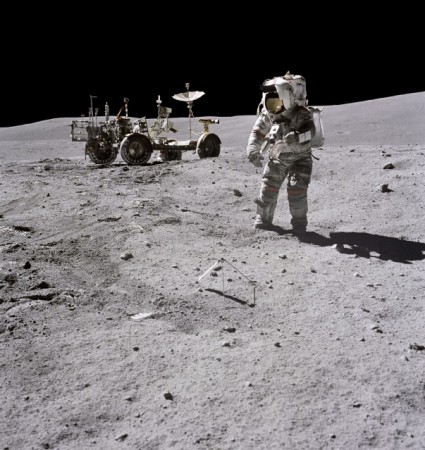
As the conversation progressed, and the language became increasingly more blue, it was left to Capcom Tony England to advise an embarrassed Young that the world could hear his every word. Needless to say, the astronauts communicated less overtly about their bowel movements for the remainder of the mission.
EVA-2 on 22 April 1972 saw them drive halfway up the side of Stone Mountain, achieving the highest altitude ever attained by an Apollo crew. The beauty of their surroundings was overwhelming, even for the irreverent Young and Duke. In fact, Duke later recalled that it was easy to lose sight of the fact that, if either man sprang a leak in his space suit, it meant near-instant death. Yet the Moon did not appear a hostile place, with its black sky and gently rounded mountaintops. “We did not feel like we were intruders,” he wrote on his website, www.charliedukestory.com, “in this foreign, foreign land.”
Forty-five years ago, to this very day, on 23 April 1972, Young and Duke clambered down Orion’s ladder for their third and final Moonwalk on Apollo 16. As they continued to sample Descartes, and continue to find many breccias, they were struck not only by the barrenness of the landscape, but also by the near-impossibility of judging distance. Chiefly, this was due to the lack of a substantial atmosphere. On one occasion, Duke dashed towards a seemingly distant boulder to collect it.
“It may be further away than we think,” cautioned Young.
“Nah, it’s not very far,” replied Duke.
“Theoretically, huh?” deadpanned Young. “Like everything else around here. A couple of weeks later…”
Beneath Young’s dry wit lay the reality that depth perception was notoriously difficult on the Moon, with no atmosphere and no landmarks with which to gain one’s bearings. By the time Duke reached his “small” boulder, it turned out to be much further away—and far bigger—than anyone had anticipated. By the astronauts’ estimations, it was about 65 feet (20 meters) across and 40 feet (12 meters) high. They dubbed it “House Rock”.
A day later, on 24 April, following a smooth ascent from the surface and redocking with Mattingly aboard the CSM, the Apollo 16 crew were on their way back to Earth. During the return journey, Mattingly performed an 84-minute trans-Earth EVA, to retrieve film cassettes. At one stage, he feared that his wedding ring had gone missing. He had only gotten married a couple of years earlier. Fortunately, Duke spotted something about the float through the spacecraft’s hatch. It was the ring. Mattingly caught it, just in time.
Returning safely to Earth on 27 April, the flight of Young, Mattingly and Duke was the second-to-last piloted expedition to the Moon in the 20th century. A few months later, Gene Cernan, Ron Evans and Jack Schmitt voyaged across 240,000 miles (370,000 km) of cislunar space again, fully aware that theirs was likely to be the last mission of its type for some considerable time to come. No one could have foreseen that it would be at least a half-century before even a glimpse of humans returning to their closest celestial neighbor would again enter the realms of possibility.
This is part of a series of history articles, which will appear each weekend, barring any major news stories. Next week’s article will focus on Space Shuttle Endeavour, as we approach the 25th anniversary of her maiden voyage.
Be sure to “LIKE” AmericaSpace on Facebook and follow us on Instagram & Twitter!
Missions » Apollo »



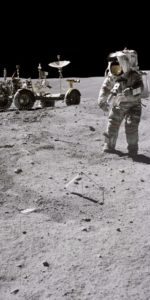
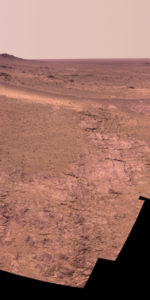
“No one could have foreseen that it would be at least a half-century before even a glimpse of humans returning to their closest celestial neighbor would again enter the realms of possibility.”
Thank you again Ben Evans for another great history article.
It is time for humans to return to the Moon and this time to stay and tap its frozen water and many other resources and use them to accelerate the development of Cislunar Space.
“The Constellation program, which gave birth to these technologies, dates to the NASA Authorization Act of 2005. The law directed NASA to pursue a sustained human presence on the moon as a precursor to going to Mars.”
From: ‘Here Is the Trump Transition Team’s Big Plan for NASA
Popular Mechanics met with astrophysicist Jack Burns, a member of President Trump’s NASA transition team, to learn a little about what we can expect from the agency moving forward.’
By Jay Bennett April 26, 2017
At: http://www.popularmechanics.com/space/moon-mars/a26025/nasa-future-jack-burns-moon-mars-sls-orion/
“The European Space Agency (ESA) and the China National Space Administration (CNSA) have begun discussions regarding a potential collaboration on a lunar human outpost and related technologies. CNSA led a series of talks with ESA, and secretary general for China’s space agency, Tian Yulong, discussed the potential for a lunar base on Chinese state media, according to the Independent.”
From: “China, European Space Agency Plan to Collaborate on ‘Moon Village’
Two ambitious programs meet for something even more ambitious.”
By David Grossman April 26, 2017
At: http://www.popularmechanics.com/space/moon-mars/a26225/china-european-space-agency-collaborate-moon-village/
Note also:
“Trump, sitting in the Oval Office at the White House, asked the astronauts about when NASA would be ready to send humans to the planet. ‘What do you see a timing for actually sending humans to Mars?’ he asked.
‘Well, I think as your bill directed, it will be approximately in the 2030s,’ responded Whitson, referring to a NASA authorization act that Trump signed into law March 21.
And, “‘Unfortunately, spaceflight takes a lot of time and money, so getting there will require some international cooperation to get it to be a planet-wide approach in order to make it successful, just because it is a very expensive endeavor,’ Whitson said. ‘But it so worthwhile doing.'”
From: ‘Trump’s exuberance for Mars faces technical and fiscal challenges’
By Jeff Foust April 24, 2017
At: http://spacenews.com/trumps-exuberance-for-mars-faces-technical-and-fiscal-challenges/
“Bill was fluent in space, technology, science, history, politics and the Moon. He contributed to the conversation in books, through numerous articles printed in well-known publications throughout the years, and by his generous outreach to people of every age who were interested (or showed promise) in learning more about aviation, space and astronomy. He kept us all honest and on our toes, and in the process taught us much by commenting at my blog (and other blogs)—always intelligently and politely as he engaged in debate. His wide knowledge and understanding of the history of spaceflight and aviation informed his comments and added much needed clarity and understanding.”
From: ‘Bill Mellberg, a Clarifying Voice
Farewell to a wise and thoughtful commentator on space.’
By Paul D. Spudis airspacemag.com April 20, 2017
At: http://www.airspacemag.com/daily-planet/bill-mellberg-clarifying-voice-180962969/
Note:
“BEIJING – Representatives of China and the European Space Agency are discussing potential collaboration on a human outpost on the moon and other possible joint endeavours, according to a spokesman for the European agency and Chinese media reports.
The secretary general for China’s space agency, Tian Yulong, first disclosed the talks about the envisioned lunar base in Chinese state media. They were confirmed Wednesday by Pal Hvistendahl, a spokesman for the European Space Agency, or ESA.”
And, “The director general of the 22-member ESA, Johann-Dietrich Woerner, has described its proposed ‘Moon Village’ as a potential international launching pad for future missions to Mars and a chance to develop space tourism or even lunar mining.”
From: “China and Europe want to build a ‘Moon Village'”
By The Associated Press April 26, 2017
At: http://www.macleans.ca/politics/worldpolitics/china-and-europe-want-to-build-a-moon-village/
“What makes your plan for eventual mineral extraction different than, say, Planetary Resources, which aims to capture and mine asteroids?
With the naked eye, we see the moon is covered in craters. Those are from asteroids. The moon is, essentially, an aggregator of asteroids. So as opposed to mining an individual asteroid, why wouldn’t you just go somewhere that’s been aggregating many asteroids for billons of years?
If you do find valuable minerals, how would you actually get them back to Earth?
Coming back is actually the easy part. We use the Earth’s gravity and drop something into the Pacific Ocean with a beacon.”
From: “How The First Private Landing On The Moon Could Move Humanity Forward A conversation with the founder of Moon Express”
By Cliff Ransom August 3, 2016
At: http://www.popsci.com/how-first-private-landing-on-moon-could-move-humanity-forward
Yep, an international human and robotic Moon Village to mine Lunar resources is beginning to look likely.
Note:
“While he wasn’t on the panel that got the question about lunar exploration, ESA director general Jan Wörner did put in a plug later in the session for his ‘Moon Village’ concept of an international lunar base, which he said was essential before humans could go to Mars.
“‘We think that the Moon is a very important step. Mars is not the ultimate goal; humans will go further than Mars,’ he said. The Moon, he added, offered ‘special opportunities’ for developing new technologies, including the production and assembly of hardware as well as a source of resources.”
From: ‘International and commercial interest in the Moon’ By Jeff Foust 4/24/2017
At: http://thespacereview.com/article/3223/1
And:
“Dear colleagues We want to invite you to participate and submit abstracts for European Planetary Science Congress 2017 17–22 September 2017 in Riga, Latvia http://www.epsc2017.eu/ The intention of the European Planetary Science Congress 2017 is to cover a broad area of science topics related to planetary science and planetary missions.”
And, “The Moon Village is an open concept proposed by ESA DG with the goal of a sustainable human and robotic presence on the lunar surface as an ensemble where multiple users can carry out multiple activities. – Multiple goals of the Moon Village include planetary science, life sciences, astronomy, fundamental research, resources utilisation, human spaceflight, peaceful cooperation, economical development, inspiration, training and capacity building. Lunar science and exploration are developing further with new and exciting missions being developed by China, the US, Japan, India, Russia, Korea and Europe, and with new stakeholders.”
From: ‘Moon Village and ILD at the EPSC2017’
At: https://ildwg.wordpress.com/moon-village-and-ild-at-the-epsc2017/